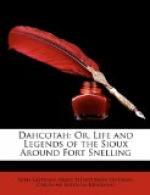The first impression created by the Sioux was the common one—fear. In their looks they were so different from the Indians I had occasionally seen. There was nothing in their aspect to indicate the success of efforts made to civilize them. Their tall, unbending forms, their savage hauteur, the piercing black eye, the quiet indifference of manner, the slow, stealthy step—how different were they from the eastern Indians, whose associations with the white people seem to have deprived them of all native dignity of bearing and of character. The yells heard outside the high wall of the fort at first filled me with alarm; but I soon became accustomed to them, and to all other occasional Indian excitements, that served to vary the monotony of garrison life. Before I felt much interest in the Sioux, they seemed to have great regard for me. My husband, before his marriage, had been stationed at Fort Snelling and at Prairie du Chien. He was fond of hunting and roaming about the prairies; and left many friends among the Indians when he obeyed the order to return to an eastern station. On going back to the Indian country, he met with a warm welcome from his old acquaintances, who were eager to shake hands with “Eastman’s squaw.”
The old men laid their bony hands upon the heads of my little boys, admired their light hair, said their skins were very white; and, although I could not then understand their language, they told me many things, accompanied with earnest gesticulation. They brought their wives and young children to see me. I had been told that Indian women gossiped and stole; that they were filthy and troublesome. Yet I could not despise them: they were wives and mothers—God had implanted the same feelings in their hearts as in mine.
Some Indians visited us every day, and we frequently saw them at their villages. Captain E. spoke their language well; and without taking any pains to acquire it, I soon understood it so as to talk with them. The sufferings of the women and children, especially during the winter season, appealed to my heart. Their humility in asking for assistance contrasted strongly with the pompous begging of the men. Late in a winter’s afternoon, Wenona, wife of a chief named the “Star,” came to my room. Undoing a bundle that she took from under her blanket, she approached and showed it to me. It was an infant three days old, closely strapped to an Indian cradle. The wretched babe was shrivelled and already looking old from hunger. She warmed it by the fire, attempting to still its feeble cries.
“Do you nurse your baby well, Wenona?” I asked; “it looks so thin and small.”
“How can I,” was the reply, “when I have not eaten since it was born?”




